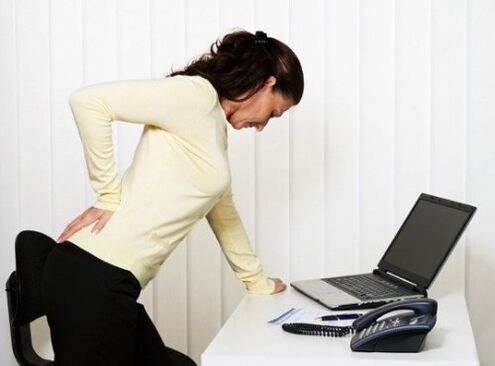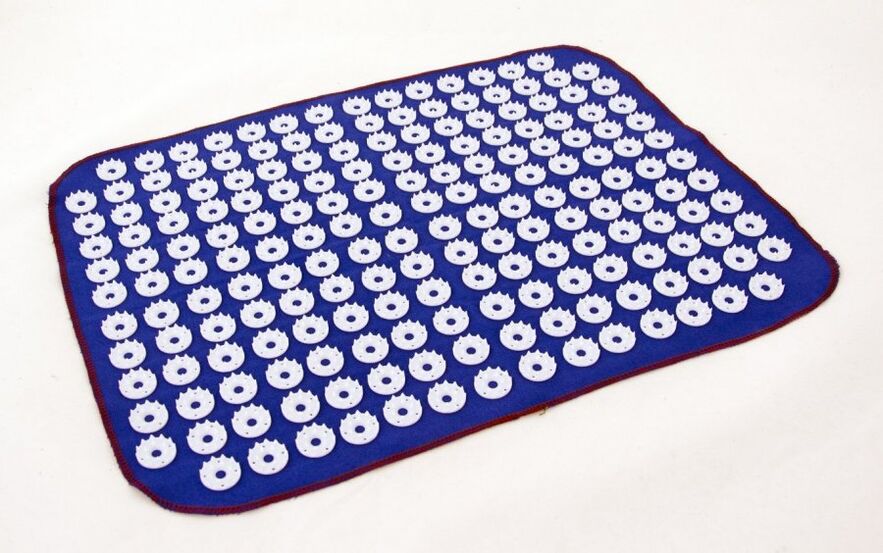
According to medical statistics, pain in the back of 80% of cases is caused by lumbar osteochondrosis.This occurs as a result of degenerative changes in this segment, when intervertebral discs and adjacent vertebrae are affected.The osteochondrosis of the lumbar column (SPEP) is manifested by several symptoms: pain of a different nature, limitation of mobility, altered sensitivity of the lower part of the body, etc.With a long absence of treatment, degenerative processes apply to vertebrae, the capacity for work reducing, the patient can become a disabled person.
To avoid dangerous complications of lumbar osteochondrosis (PO), comprehensive treatment in 1-2 stages of pathology must begin.In advanced cases, when irreversible changes in the disk or vertebrae are already present, surgery is performed.To avoid the low back osteochondrosis and related complications, it is necessary to carry out their prevention.
The development of lumbar osteochondrosis
To understand what pop osteochondrosis (lumbar column) is, you must study the structure of the spine.It consists of the vertebrae, among which cartilage joints (intervertebral disc) are placed.The disc is covered with a hard fibrous membrane (fibrous ring), within which there is an octopoose core.This structure performs a shock agitation function, makes the column more flexible.
Reference.The lumbar segment of the column is subjected to a great load daily, since it resists the weight of the upper body.Therefore, the osteochondrosis of the lower column is diagnosed more frequently than the cervical thorax.
With regular charges in the column, the discs are compressed, many fluids are lost, their height and the distance between the vertebrae decreases.The cartilaginous joint becomes fragile, microcks appear on its surface, through which the octopoal nucleus stands out over time.With the additional compression of the intervertebral discs, the external membrane and the loss of the gelatinous body are produced, the hernia is formed.Then the pathological mobility of the vertebrae occurs, increases the load in the neighboring segments of the spine.
A little later, bone growths (osteophytes) begin to form at the edges of vertebral bodies.Therefore, the body is trying to stabilize the spine.
Doctors distinguish 4 stages of lumbar spine osteochondrosis:
- 1 Grade: Disc problems begin, the central part is dehydrated, they are flattened, cracks appear on the outer cover.It has a atted.
- 2 degrees: The boxes of the cartilage joint, the vertebrae approach each other, become more mobile, muscles and ligaments around the barley of column.The pain appears.
- 3 degrees are formed: protuberance, hernias, subluxation of the vertebrae.The pain increases, mobility is limited, the sensitivity of the lower part of the body is affected.
- Fourth grade osteochondrosis is characterized by the appearance of osteophytes that can damage spinal nerves, vertebrae neighbors.There is constant pain, pronounced neurological disorders and other complications, increases the risk of disability.
It is easier to cure lumbar condrosis (stage 1), however, it is very difficult to detect the disease at this stage.The second degree intervertebral osteochondrosis is treated by using conservative methods.In 3-4 stages, an operation may be necessary.
Reference.According to statistics, SPP is detected more frequently in patients after 30 years.There are frequent cases of pathology in people after 20 years.Approximately 80% of 60 -year -old patients suffer from the manifestations of this disease.
Reasons
To understand how to deal with pkop osteochondrosis (lumbosacral column), you need to know your reasons:
- Regular static or dynamic load in the lumbar segment.The Risk Group for the Development of Osteochondrosis includes office workers, professional athletes (heavy athletics), motors, builders, etc.
- Posture violation, prolonged in the mistaken.
- Genetic predisposition, abnormalities of the formation of vertebral bodies.This category includes youth software: spinal column curvature caused by pathologies of vertebral bodies.
- Spine injuries.
- Hormonal imbalance, metabolic disorders, endocrine diseases that interrupt metabolism in the lumbar segment.
- Changes related to age in the body cause the wear of the discs.
- Bone tuberculosis, osteomyelitis (purulent inflammation of bone tissue), ankylosing spondylitis (inflammation of vertebrae and joints), rheumatoid arthritis, etc.
Often, the disease causes several reasons at the same time.
In addition, there are factors that cause the development of lumbar osteochondrosis:
- Excess body weight.
- Passive lifestyle, prolonged seat.
- Regular use of harmful foods (fats, fried foods, confectionery, semi -ends, etc.).
- Lack of liquid, dehydration.
- Congenital disorders of the structure of the column, for example, an additional vertebra.
- Use regular awkward heels.
- The period of carrying the fetus, then the load in the spine increases.
- A strong abandonment of professional training athletes or excessive sports in people who have previously been passive.
- Smoking, frequent and immoderate alcohol consumption.
There are many more factors that can launch distribution degenerative processes in the lumbar column.For example, flat feet, frequent hypothermia, frequent stress, sleep disorders, etc.

Symptoms
The symptoms of the osteochondrosis of the lumbar column are diverse, depend on the pathology and location stage of the affected area.
Doctors distinguish reflex and compression syndromes (a symptoms complex) for SPP.The former occur with irritation of the external membrane receptors of the discs, ligaments, joint capsules and the second, when compressing the nerve packages, the blood vessels, the spinal cord.
There are such reflex syndromes of lumbar osteochondrosis:
- Lumbago.Firing the pain at the bottom of the back with an acute movement or tension.In the slightest attempt to move, pain syndrome is improved, so the patient freezes in a pose.The muscles in the damaged area are strongly tense, in the palpation, the painful sensations become more pronounced.These manifestations are associated with the movement of the octopo core within the outer cover.
- LumbalgiaA real pain is developed for several hours or days.The discomfort intensifies with the movements, a change in the position of the body.It weakens when a person takes a horizontal pose with a roller under the lower back.When raising a straight leg in this position, the pain intensifies (Lassa symptom).The degree of muscle tension is less than lumbar.The lower back mobility is limited.
- Sciatica.Painful sensations (acute or sore) spread from the bottom of the back to the bottom of the body.There is an increase in this feature during movements.The pain weakens when resting on the back.The muscles in the affected area are tensioned, pain syndrome is expressed in palpation.
The symptoms in compression syndromes depend on which lumbar segment sections are damaged.The characteristic signs are associated with the compression of the cerebrospinal nerves with hernias, osteophytes, displaced vertebrae.This condition is called the radicle, in which the pain intensifies with the slightest movement, the lower back muscles are tense and mobility is limited.
Clinical manifestations of compression syndromes depending on the damaged vertebrae of the lumbar segment:
- L1 - L3 - pain and numbness in the area of the lower back, the front and internal surface of the thigh, it is difficult for the patient to bend/not be the leg in the knee.
- L4 - The pain syndrome extends to the front of the thigh, falls to the knee (behind).In the same area, sensitivity is violated.
- L5: The painful sensations radiates in the buttocks, the outside of the thigh, falls along the front of the bottom of the inside of the foot and the thumb.In the same area, numbness feels, it is difficult for the patient to fold the thumb.
- S1: The pain spills from the bottom of the back to the buttock, the outer and posterior surface of the thigh, falls to the outside of the lower leg, foot.In these areas, the numbness is felt, the muscles at the bottom of the leg weaken, so the patient is difficult to stop on the socks.
There is a risk of damage to several nerve beams at the same time, for example, L5, S1.If the hernia returns back, then you can press the spinal cord.
With the compression of the low back blood vessels, the probability of weakening the muscles of the legs, the numbness of the lower extremities, a violation of the control over the urine and defecation process increases.In men, an erection is altered in men, and in women the main symptoms can be complemented by the inflammation of the ovaries or the uterus.
Diagnostic measures
To diagnose the SPP, the doctor examines the patient, carries out the palpation to determine the condition of the muscles and identify the curvature of the spine.It is important to tell a specialist in detail about his symptoms to make it easier for him to make a diagnosis.
Instrumental research will help detect intervertebral osteochondrosis:
- Rail from the lower back (direct and lateral projection).
- Calculated and magnetic tomography of rejection.
X -Ray allows you to evaluate the pop structure.To identify the pathological mobility of the vertebrae, X -rays is carried out in the flexion and extension position.This study allows us to notice that the intervertebral gap has been reduced, the bodies of the vertebrae have changed, the osteophytes appeared at their edges.However, this diagnostic method is considered outdated.
Today, TC and magnetic resonance are increasingly used to detect changes of distribution degenerative in the spine.These highly informative studies allow you to evaluate the condition of vertebrae, discs, intervertebral holes, spinal cord.With their help, protrusion, the direction of the hernia, the degree of compression of nerve beams, the spinal cord, the blood vessels are revealed.
Treatment
Lumbar osteochondrosary medications

The treatment of Pop osteochondrosis lasts from 1 to 3 months to 1 year.The success of the therapy depends on the patient itself, who must strictly observe the doctor's recommendations.With the auto -medication, the patient's condition generally worsens.
Therapy therapies:
- Stop or weaken software symptoms.
- To identify the cause of the disease, try to exclude it from life.
- Eliminate the inflammatory process.
- Restore blood circulation, metabolic processes in the lumbar region.
- Try to improve the condition of damaged cartilage joints, stop more degenerative changes.
To achieve such objectives, it is recommended to carry out complex therapy.Usually, it begins to take drugs:
- Musorelaxantes.They relax the muscles, weaken pain and inflammation.
- NSAID.They have anti -inflammatory, analgesic and antipyretic antipyretic effects.
- Antispasmodics.They help stop the spasm of the smooth muscles, weaken pain.
- Anesthetic agents.They are used for severe pain in therapeutic blockade.
- Glucocorticosteroids.They also help face pain.However, these funds can destroy the bones, so they take them for a short time and only after the doctor's approval.
- SedativesRemove neuromuscular tension, improve sleep.
- Vitamins (Group B, E, C, A).Restoring the condition of the affected nerves, weakens the pain.
Carefully.The NSAIDs is prohibited from taking with gastritis or stomach ulcer, since even more damaging the mucous membranes of the gastrointestinal tract.
With the exacerbation, the patient with injections is injected, and after stopping the main symptoms, he takes oral agents.
In addition, external products (gels, ointments, cream, garbage) are used.
The question of what to do with chronic lower back osteochondrosis is quite relevant.If the SPP has become chronic, then, after the main symptoms, the patient, the patient receives condoprotectors, medications that restore blood circulation, medications based on vitamins B. help restore inertation, normalize blood supply in the affected area and prevent the additional development of the pathology.
The treatment of lumbar column condrosis (stage 1) is carried out using condoprotectors that slow down the development of degenerative processes, accelerate the regeneration of the cartilage.In addition, the patient is prescribed mineral vitamins.This form of osteochondrosis is easier to cure.
Other conservative methods
With OKZ (osteochondrosis) 1 - 2 degrees, the following treatment procedures will help stop their development:
- Ultrasound therapy weakens pain and inflammation, normalizes blood flow in the damaged area.
- Dutezor therapy is a safe traction of the column due to the weight of its own body, after which muscle tone is normalized, mobility improves.
- Magnetotherapy reduces the pain and inflammation of the muscles around the spine.
- Reflexotherapy (the introduction of needles in bioactive points in the body) accelerates blood circulation, relieves inflammation and swelling.
- Manual therapy (exposure to the affected area with the hands of a doctor) and massage normalize muscle tone, reduce the compression of nerve beams, improve the power of intervertebral discs and restore the structure of the column.
- Electrophoresis allows you to administer medicinal solutions through the skin to bone and cartilage.
- Dragon's life improves blood circulation, metabolic processes, reduces pain, restores skin sensitivity.
There are still many effective procedures that will help improve the patient's condition in 5-15 sessions.The main thing is to receive the approval of a doctor before their behavior.
Home treatment at home
If you are interested in whether it is possible to treat an OPP at home, consult a doctor.If the specialist has given permission, therapy begins, which generally consists of the following points:
- Diet.If lumbar osteochondrosis is caused by a violation of blood flow or metabolism, it excludes fatty, fried, spicy foods, eggs, etc.In the menu, replace the menu with fresh vegetables, fruits, low -fat meat, fish, agricultural products.Rek alcohol, tonic drinks (tea, coffee).Drink filtered water, compote, herbal teas.
- To restore blood circulation, load or use friction and compress.
- Sleep in an orthopedic mattress, a low pillow.If you have a sedentary work, buy a chair with a backup that supports the spine.From time to time, use corsets or special belts.
- Exercise therapy will help strengthen the muscle corset, eliminate part of the spine load.The complex for each patient individually constitutes a doctor or instructor.
- Make the car -Ssess of the lumbar region.However, discover how to do it correctly with a professional.
- Use popular remedies in friction, compresses, bathrooms, etc.
- Acupuncture is a plastic plaque with many peaks that improve blood circulation, metabolic processes in the damaged area, reduce muscle pain, relaxes.

And also at home you can use lotions with herbal decoctions, plasters.
Reference.The novelty in the treatment of osteochondrosis is a massage bed that is adequate even for the most inorganized patients.
However, remember that it can only be treated at home after the permission of the attending physician.
Surgical treatment
The operation with lumbar osteochondrosis is prescribed whether conservative methods have been ineffective for a long time.And also the surgical intervention is indicated with involuntary urination, defecation and horsetail syndrome (pinch of the lower spinal cord nerves).
In the treatment of SPP, such surgical methods are used:
- Spondylodeza - Fusioning adjacent vertebrae.
- Fassetextomy: Elimination of intervertebral joints that violate the cerebrospinal nerve.
- Laminectomy: Elimination of a plaque that covers the spinal channel that squeezes the spinal cord.
- Discoctomy is a complete or partial elimination of the intervertebral disc, which causes a nerve compression or spinal cord.
- CORPECTOMY: Elimination of the vertebra body and adjacent cartilage joints.Then, the empty place is filled with a bone transplant and 3 vertebrate segments are spent.
Reference.After surgical intervention, there is a risk of complications: trauma of the spinal cord, nerve beams, decomposition of transplants, infection, etc.
After treatment, it is necessary to undergo rehabilitation to accelerate recovery.
Complications
In the absence of competent therapy, it increases the risk of such complications of lumbar osteochondrosis:
- Disco hernia, pincon of nerve root or spinal cord.
- Long -term inflammatory processes increase the probability of radiculitis (inflammation of nerve roots).
- Ishias (inflammatory to the sciatic nerve), in which severe pain and lower limb numbness occur.
- In case of deteriorated blood circulation of the spinal cord, the probability of compression myelopathy (compression of the spinal cord with several formations: bone fragments, hernia, tumors, hematoma) increases.
- The horse's tail syndrome is the compression of the roots of the lower spinal cord, which leads to a violation of the functionality of the intestines, the pelvic organs and the lower extremities.
To avoid such complications, treatment must begin as soon as possible.
Prevention
To avoid lumbar osteochondrosis, follow the following rules:
- Directing a moderately active lifestyle (walk more frequently on foot, exercise regularly, register in the pool).
- When sitting, warm every 1.5 hours.
- Sleep in the orthopedic mattress.
- Avoid excessive physical effort, lift the gravity only from the position of semi accuracy, before that, put a special belt on the lower back.
- Buy orthopedic shoes.
- Eat correctly, take mineral vitamins as prescribed by a doctor.
- Learn to relax.
- Try non -hypothermia.
- Over time, try the diseases that can cause an spp.
- Reject bad habits.
Subject to these recommendations, you can avoid degenerative changes in the spine and improve your health.
The most important thing
If you notice the symptoms of lumbar osteochondrosis, consult an urgent doctor.Independent treatment can aggravate your condition and cause complications.Lumbar condrosis (first stage) is treated with exercise therapy, physiotherapy and condoprotectors.In the posterior stages, drugs, massages, manual therapy, etc. are used.In the absence of positive dynamics for a long time or the appearance of neurological symptoms, the doctor can prescribe an operation.The patient must strictly follow the doctor's recommendations to accelerate recovery.



































